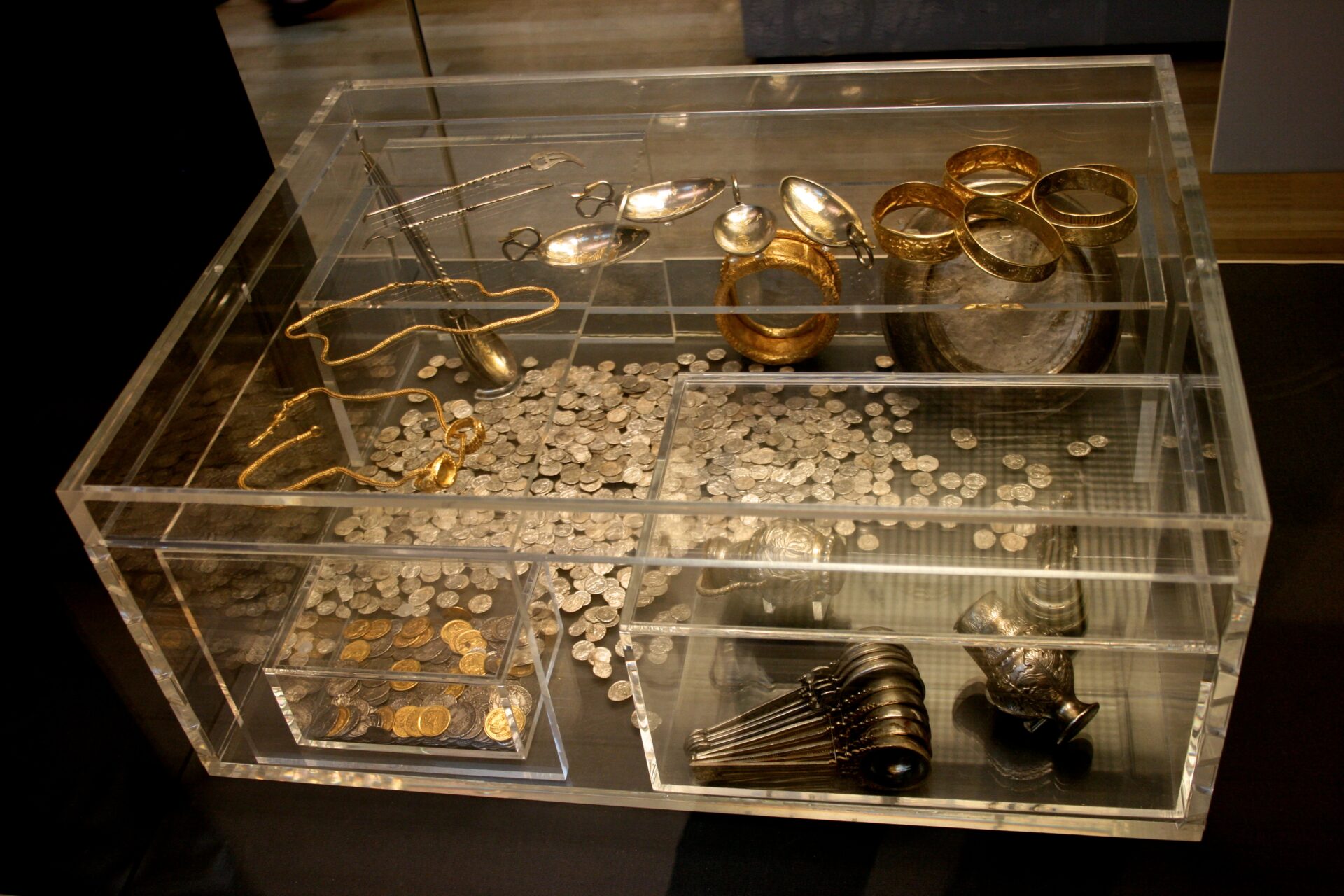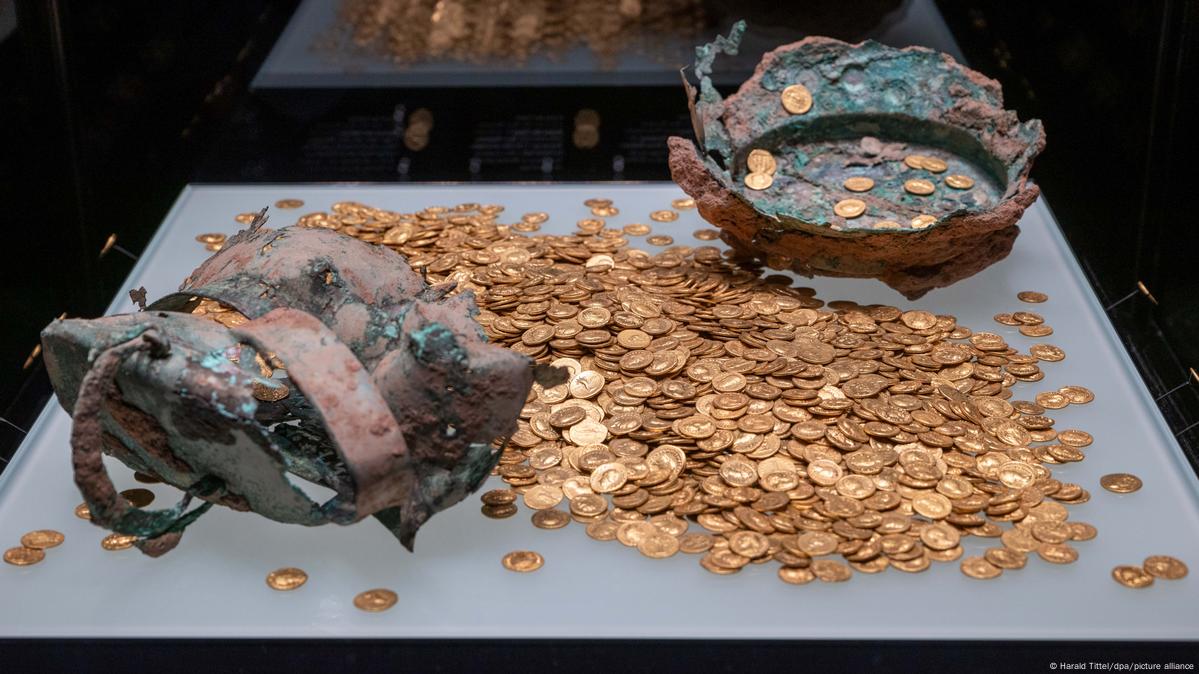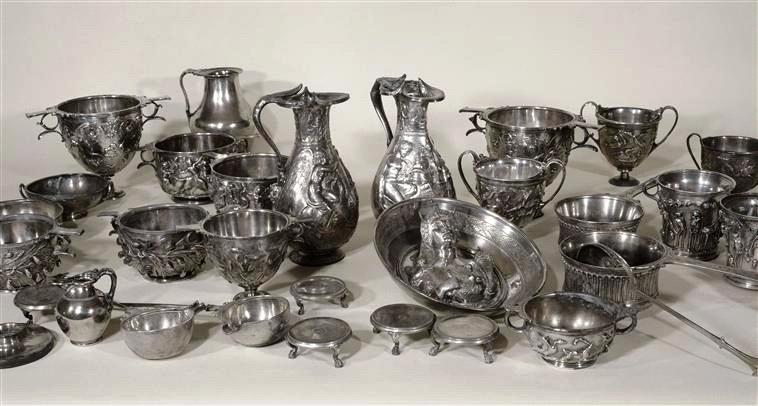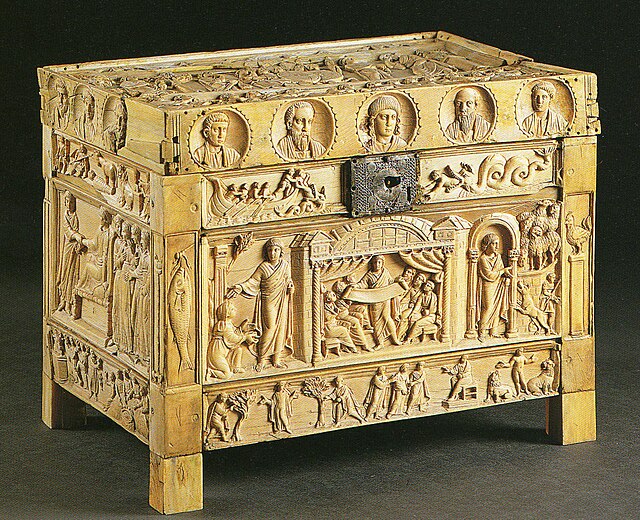Dr. Garrett Ryan introduces a captivating exploration of Roman treasures, focusing on their worth through the lens of bullion value. Instead of assessing artistic significance, he ranks these treasures based on the raw value of the gold and silver they contain. This approach sheds light on the historical richness of the Roman era, offering a glimpse into the tangible wealth of the times.
From the Hoxne Hoard found in England to the Trier Gold Hoard in Germany, each discovery tells a fascinating story of wealth hidden and sometimes lost. Dr. Ryan’s method, influenced by Dr. Richard Hobbs’ formula, calculates the value in terms of ancient soldiers’ wages, providing a practical perspective on the immense worth of these relics.
Key Takeaways
- Roman treasures are ranked by the precious metal value they hold.
- Discoveries highlight the wealth hidden during turbulent times in history.
- Dr. Ryan uses a unique approach to assess these treasures’ historical worth.
How to Determine the Value of Roman Treasures
Valuing Roman treasures based on their precious metal content provides insights into their historical worth. This approach looks at how much gold or silver the treasures contain rather than their artistic value. Roman treasures often come in the form of gold coins, silver tableware, or other valuable items. Calculating their worth involves understanding the bullion value, which refers to the market value of the metal itself.
Consider the Hawkson Hoard discovered near an English village. Found in 1992 by Eric Laws using a metal detector, this treasure included gold jewelry, silverware, and over 15,000 coins. The hoard’s bullion value when it was buried was equivalent to 5.2 kilograms of gold. At that time, this could pay 230 soldiers’ yearly wages.
The Trier Treasure found in 1628 included 114 kilograms of silverware. Despite its artistic worth, it was measured by its bullion value, equivalent to 7.5 kilograms of gold. Such an amount paid the salaries of 330 soldiers.
The Boscoriale Treasure from just outside Pompeii during the eruption of Mount Vesuvius included nine kilograms of gold coins and 30 kilograms of silver. It had a bullion value similar to 11 kilograms of gold. This treasure could cover the annual salaries of 170 Roman soldiers.
Each treasure’s worth, determined by bullion content, gives us insight into the economic realities of the Roman era. By translating these values into soldiers’ pay, historians can better comprehend the treasures’ significance to ancient people.
Hoxne Treasure

Unearthed Findings and Items
In November 1992, near Hoxne, England, a farmer misplaced his hammer in a field. Unable to locate it, he sought help from his friend, Eric Lawes, who used a metal detector he had received as a retirement gift. During the search, Lawes’ detector signaled, prompting him to dig. His effort revealed a glimmer of gold in the soil. Recognizing the significance, Lawes contacted local authorities. Experts soon arrived and transferred the findings to the British Museum. The hoard consisted of gold jewelry, silver tableware, and over 15,000 coins in gold, silver, and bronze. All these relics were meticulously packed into a wooden chest and buried during the 5th century, a time when Roman Britain faced invasions and turmoil.
Past Significance and Worth
When first uncovered, the Hoxne collection was valued at £1,750,000. Today, it’s valued at approximately £3.5 million or around $5 million USD. To understand its value during the time of burial, a method devised by Dr. Richard Hobbs from the British Museum can be applied. This shows that the hoard had a bullion value equivalent to 5.2 kilograms of gold. At that time, a soldier in the Roman army earned about five gold coins annually, making the hoard sufficient to pay 230 soldiers for a year.
Trier Treasure

Discovery and Unearthing
In the early winter of 1628, a remarkable find occurred within the city of Trier. Six young men from a local religious order were busy in a garden, clearing the way for a new building’s foundation. While digging, they hit upon something solid beneath the earth. After some effort, they exposed a stone chest lid. Curious and eager, they pried it open to discover an astonishing collection of Roman silverware.
This trove held nearly 50 different items made of silver. The pieces ranged from elegant drinking vessels to grand and intricately designed serving trays. These treasures were thought to have been hidden during a chaotic time when Trier was facing threats from outside forces.
Make-Up and Financial Worth
The unfortunate fate of this treasure saw it confiscated by a ruling authority. The silverware did not remain intact for long; it was broken down and melted to create new coinage. During this process, it was discovered that the hoard contained approximately 114 kilograms of pure silver. According to a valuation method used for such finds, this amount of silver equaled about 7.5 kilograms of gold at the time it was buried.
This quantity of gold represented a significant sum, capable of paying the yearly wages of around 330 soldiers from the late Roman period. This illustrates the immense monetary value such a find held during its time of concealment.
Treasure of Boscoreale

How It Was Preserved
In the area just outside Pompeii, Mount Vesuvius erupted, causing a shower of ash and tremors from the earthquakes. The villa owner decided to hide a chest full of valuable items beneath the wine pressing room floor. Whether this person made it out alive is unknown, as a skeleton was later found nearby, and they never returned for the hidden riches. In 1895, when the treasure was uncovered, it included 102 silver items that were considered works of art. Some of them dated back several centuries when buried. Over 1,000 golden coins, known as aurei, were also found. The intense heat from the volcanic eruption had altered the coin surfaces, creating a reddish glow.
What Happened to the Treasure
After its discovery, much of the Boscoreale treasure was quickly taken out of Italy and entered the international market for antiquities. The most exquisite pieces of silver were bought by the financier Edmond de Rothschild, who later donated them to the Louvre Museum. Other items were secured by institutions like the British Museum, while many of the coins ended up in private collections. Altogether, the treasure included approximately nine kilograms of gold coins and thirty kilograms of silver, making it extremely valuable. When buried, it was worth the same as roughly 11 kilograms of gold. At that time, Roman soldiers, known as legionaries, received annual wages that the treasure could have paid for 170 of them or for nearly 500 soldiers from later periods, who earned less.
Trier Gold Collection

Finding the Hoard and What It Contains
On the afternoon of September 9, 1993, amateur coin hunters were exploring the foundation of a new parking lot near the center of Trier. They stumbled upon some gold coins. Later that evening, one of the hunters, Eric Aiksner, went back to the site, curious to see if more treasures were waiting. As he searched through the remains of an old Roman building’s basement, his metal detector started beeping loudly. A tractor had broken open a bronze cauldron, revealing more gold coins. Though a few had fallen into the hole, most remained near the base of the cauldron. Aiksner quickly gathered a huge lump of stuck-together coins and collected the rest in a plastic bag. The next day, he informed the local museum about his find. The Trier collection included around 2,650 early imperial coins, which were likely hidden during a time of civil unrest in the late third century. Together, these coins weighed about 18.5 kilograms.
Worth and Historical Context of the Collection
When these coins were originally hidden, Roman soldiers typically earned 12 coins per year. This means the Trier collection could have provided yearly salaries for 220 mid-imperial soldiers or 822 later era soldiers.
Reka Devnya Treasure

Initial Discovery
On November 10, 1929, a remarkable find took place in the Bulgarian village of Devnya. Situated on the remnants of the ancient Roman city of Marcianopolis, a resident came across two large vases while digging in his backyard. These containers were filled with silver coins. Local authorities learned of this significant discovery, but not before a large portion of these coins had already been sold off, significantly complicating the process of assessing the full extent of the find.
Size and Worth Evaluation
The initial hoard was estimated to contain over 100,000 coins, primarily silver denarii, intended to be hidden during the tumult of the Gothic invasion around 250 AD. The coins that were eventually recovered were packed into seven crates for study in various museums. The entire treasure, with a staggering weight of about 350 kilograms, was equal to roughly 23 kilograms of gold in value. This amount would have been sufficient to cover the annual earnings of over a thousand soldiers during the later period of the Roman Empire.
The Brescia Hoard

Historic Discovery of the Military Pay Chest
In 1714, a significant Roman discovery was made near the town of Bresciello in northern Italy. A peasant working the land uncovered a substantial vessel. This was believed to hold the contents of a Roman army‘s pay chest. Such treasures were often concealed by military leaders during times of turmoil and civil war.
The vessel contained a remarkable collection of coins, indicative of the substantial sums that were used to pay Roman soldiers. It’s thought to have been buried during the chaotic period that followed the death of a prominent Roman leader. The exact value in terms of gold weight and the historical context further emphasize the significance of this find.
These coins are a testament to the rich history of Roman military finance and reflect the immense wealth that was handled during that era.
Dr. Garrett Ryan’s Approach
Gold and Silver Value Order
Dr. Garrett Ryan ranks Roman treasures based on their bullion value. This means the treasures are evaluated by the worth of the gold and silver they contain, rather than their artistic or cultural significance. Such a method helps to understand the economic impact of these treasures when they were hidden.
For example, the Hawks and Horde had a bullion value equivalent to 5.2 kilograms of gold. In its time, this amount could pay the annual salaries of around 230 foot soldiers. Another case, the Trier Treasure, had silver valued at about 7.5 kilograms of gold, enough to cover the salaries of 330 soldiers. The method shows how much wealth was needed to secure the futures of individuals or armies in those times.
